Ken MacLeod's Blog, page 15
June 27, 2012
Naming the prey
The other night Carol and I were half-watching an episode of David Attenborough's Living Planet after dinner. Dinner is what it was all about. The starter (vegetarian) was a phytoplankton bloom, followed by an explosion of krill. Carol nodded at the screenful of scrabbling crustacea and said: 'It'll be difficult to think of names for all of them.' We laughed as the difficulty multiplied up the food-chain. Shoals of fish arrived to eat the krill, closely followed by a shark that ate the fish, then something really big turned up, but it turned out the whale was after the krill too, so we didn't have to name the shark.
Giving names to prey animals is a joke we've had for a few years, ever since watching a nightly week-long BBC real-time nature series about lions. All the lions were given names by the breathless presenter, possibly having already been named by the game wardens. The grazing animals that the lions hunted were simply an anonymous herd. After a few nights we got fed up with this blatant carnivorist bias from a supposedly impartial state broadcaster and started naming the antelopes.
'Will poor Doris and her little calf Freddie get away, or will their throats be torn out by ravenous lions? Find out in tomorrow evening's thrilling episode of "Rushing Around the Serengeti in Jeeps"!'
I'll never get over the end of another nature programme, set in the Arctic. The closing shot of Mummy Polar Bear (whose care for her charming, tumbling cubs we'd followed for an hour) swimming towards an ice-floe on which a seal was just visible as a black squiggle, was accompanied by the heart-rending cry from beside me: 'Look out, Sammy!'
OK, this is all a domestic in-joke and sentimental nonsense, but it would have taken a harder heart than mine to watch unmoved a later sequence in the Attenborough episode. A female whale and her newborn calf were swimming up the West Coast of the US, heading for a herring spawning or some such annual multi-layered feeding frenzy off Alaska. The rest of her pod, unencumbered by young, were hundreds of miles ahead. Out of the blue a pack of orcas turned up, looking somehow sinister in their shiny black and white SS uniforms. For six hours they harried the cow and calf, until they drove the young whale to such exhaustion that it began to drown. As it foundered, the pack moved in for the kill. You might think that after all that effort, they'd at least eat all they could of the unfortunate beast. But no. They bit off its lower jaw and part of a flipper, and left the rest for the hagfish that crowd around every dead whale on the sea-floor, and then for the bacteria, which excrete nutrients for the phytoplankton, which ...
So it goes, but what are we to make of it?
Nothing. This is just nature, and it isn't cruel. It isn't even indifferent. It's just mindless machinery thrashing about. There is no 'I' behind any non-human animal eye. Subjectivity is inseparable from language. Although emerging from animal sensation, animal emotion and animal signalling, conscious reflection and self-awareness are unique to human beings. We can name the prey, but they don't name themselves.
I very much doubt that this is the deeper meaning of the account in Genesis 2:19 of how Adam named the animals, 'and whatsoever Adam called every living creature, that was the name thereof.' (Even restricting the exercise to birds and beasts, as the King James suggests, it must have been a long day. 'Hmm, I think I'll call that one Conopophaga lineata ...') If, however, that passage had been taken as such by fundamentalists we might have been spared some of the excesses of Young Earth Creationism.

Here's how it works. One of the stumbling-blocks for YECs is the notion that suffering and death existed before the Fall. If animals suffered and died for tens of millions of years before Adam saw apple, well ... This leads YECs into all sorts of absurdities about prelapsarian vegetarian carnivores, such as the well-known case of the tyrannosaur's teeth being designed for cracking coconuts rather than ripping flesh. But if non-human animals don't have consciousness then there's no non-human suffering, and their deaths are just part of the economy of nature, not 'an evil'. The implications are above my pay grade but no doubt theologians can take it from there.
Fundamentalists are unlikely to use this conclusion from the Marxist-Leninist theory of consciousness to get themselves off the YEC hook, but I offer it nevertheless, in a spirit of charity.
Giving names to prey animals is a joke we've had for a few years, ever since watching a nightly week-long BBC real-time nature series about lions. All the lions were given names by the breathless presenter, possibly having already been named by the game wardens. The grazing animals that the lions hunted were simply an anonymous herd. After a few nights we got fed up with this blatant carnivorist bias from a supposedly impartial state broadcaster and started naming the antelopes.
'Will poor Doris and her little calf Freddie get away, or will their throats be torn out by ravenous lions? Find out in tomorrow evening's thrilling episode of "Rushing Around the Serengeti in Jeeps"!'
I'll never get over the end of another nature programme, set in the Arctic. The closing shot of Mummy Polar Bear (whose care for her charming, tumbling cubs we'd followed for an hour) swimming towards an ice-floe on which a seal was just visible as a black squiggle, was accompanied by the heart-rending cry from beside me: 'Look out, Sammy!'
OK, this is all a domestic in-joke and sentimental nonsense, but it would have taken a harder heart than mine to watch unmoved a later sequence in the Attenborough episode. A female whale and her newborn calf were swimming up the West Coast of the US, heading for a herring spawning or some such annual multi-layered feeding frenzy off Alaska. The rest of her pod, unencumbered by young, were hundreds of miles ahead. Out of the blue a pack of orcas turned up, looking somehow sinister in their shiny black and white SS uniforms. For six hours they harried the cow and calf, until they drove the young whale to such exhaustion that it began to drown. As it foundered, the pack moved in for the kill. You might think that after all that effort, they'd at least eat all they could of the unfortunate beast. But no. They bit off its lower jaw and part of a flipper, and left the rest for the hagfish that crowd around every dead whale on the sea-floor, and then for the bacteria, which excrete nutrients for the phytoplankton, which ...
So it goes, but what are we to make of it?
Nothing. This is just nature, and it isn't cruel. It isn't even indifferent. It's just mindless machinery thrashing about. There is no 'I' behind any non-human animal eye. Subjectivity is inseparable from language. Although emerging from animal sensation, animal emotion and animal signalling, conscious reflection and self-awareness are unique to human beings. We can name the prey, but they don't name themselves.
I very much doubt that this is the deeper meaning of the account in Genesis 2:19 of how Adam named the animals, 'and whatsoever Adam called every living creature, that was the name thereof.' (Even restricting the exercise to birds and beasts, as the King James suggests, it must have been a long day. 'Hmm, I think I'll call that one Conopophaga lineata ...') If, however, that passage had been taken as such by fundamentalists we might have been spared some of the excesses of Young Earth Creationism.

Here's how it works. One of the stumbling-blocks for YECs is the notion that suffering and death existed before the Fall. If animals suffered and died for tens of millions of years before Adam saw apple, well ... This leads YECs into all sorts of absurdities about prelapsarian vegetarian carnivores, such as the well-known case of the tyrannosaur's teeth being designed for cracking coconuts rather than ripping flesh. But if non-human animals don't have consciousness then there's no non-human suffering, and their deaths are just part of the economy of nature, not 'an evil'. The implications are above my pay grade but no doubt theologians can take it from there.
Fundamentalists are unlikely to use this conclusion from the Marxist-Leninist theory of consciousness to get themselves off the YEC hook, but I offer it nevertheless, in a spirit of charity.
Published on June 27, 2012 08:07
June 25, 2012
The Night Sessions hits the US atheist market
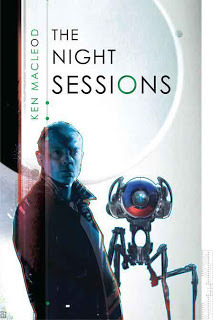
Pyr, the energetic and immensely respected publisher of the US editions of my novels The Night Sessions and The Restoration Game, is the science fiction and fantasy imprint of the even more widely respected humanist and rationalist publisher Prometheus Books. That thought always leaves me with a wicked wee smile, because I knew Prometheus Books decades before they knew me.
I first came across some of their output in the National Secular Society's old bookshop on Holloway Road, and man, it was like discovering that you had a whole unknown branch of your family who'd made it big in America. And they'd been there for generations. Robert Ingersoll! A Civil War hero, in his day the most popular lecturer in America, and they had him in print. Thomas Paine! A Founding Father, one of British rationalism's own legendary figures, and they had him in print. Along with current writers who were already on my read-everything-they-write list: Martin Gardner! Isaac Asimov!
And lots more. They're not in any way narrow or sectarian in their rationalism. They even publish books by Calvin. (And Hobbes.)
Books such as Arthur Strahler's sledgehammering geological labour of love Science and Earth History: the Evolution/Creation Controversy, and Paul Kurtz's wise, pragmatic Forbidden Fruit: the Ethics of Secularism were, looking back, essential reading in preparation for writing my own first novel, The Star Fraction. More recently, Randell Helms' Gospel Fictions and Victor J. Stenger's God: The Failed Hypothesis were somewhere in the background of The Night Sessions.
So I'm very, very proud that Prometheus is running a full-page ad in a forthcoming issue of the atheist magazine Secular World, showing off some of their featured books, and that The Night Sessions is included, in a box of its own at the foot.
Published on June 25, 2012 14:39
June 24, 2012
Charity walk
Carol (aka Mrs Early) is taking part in today's Walk for Scotland to raise money for Erskine, the charity for (often disabled) veterans. Feel free to donate here.
Published on June 24, 2012 04:33
June 16, 2012
Red Plenty debated
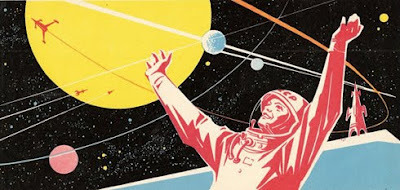
A lively discussion of Francis Spufford's novel Red Plenty (about which I've enthused before) on the academic blog Crooked Timber has just about wrapped. Participants have looked at the book from many angles. One of the most intriguing contributions was by Cosma Shalizi, on the mathematical feasibility of the linear programming advocated by the book's central character as a solution to the problem of central planning. (Shalizi responds to responses here.)
My take, amended from one of my own comments:
In the 1970s I thought that central planning combined with democratic control along the lines argued for by (e.g.) Ernest Mandel was possible and desirable. Towards the end of the decade I stumbled upon the economic calculation argument, as briefly stated by David Ramsay Steele in a readable pamphlet. I didn’t understand it fully but I kept worrying at the problem it posed. In the 1980s I read Geoffrey Hodgson’s The Democratic Economy, and Alec Nove’s The Economics of Feasible Socialism, which made some socialist sense of the same argument.
Recently I’ve been interested in the more radical market socialism proposed by David Schweickart. The only serious socialist arguments against market socialism are those of Paul Cockshott et al for a democratic, cybernetically planned economy – which I don’t have the mathematics to follow in detail, but which I keep dragging to the attention of anyone who does.
Meanwhile, in my own neck of the woods, the Scottish Socialist Party offers a 12-point plan for a ‘Scottish socialist republic’, one of whose 12 points is:
‘Supermarket prices will be frozen.’
Sometimes I wonder why I bother.
Published on June 16, 2012 04:29
May 20, 2012
Stem cell comic hits the spot, say scientists
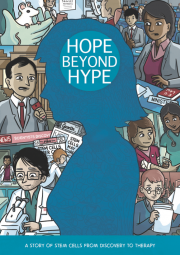
European stem cell research consortium OptiStem yesterday launched Hope Beyond Hype, a short educational comic that tells the story of stem cells from discovery to therapy. The comic, now available online and as attractive hard-copy
'starts with the true life story of two badly burned boys being treated with stem cell generated skin grafts in 1983. We then follow the successes and setbacks of a group of researchers working together to use stem cells to cure blindness, whilst being introduced to knotty issues that are part of the process, including stem cell regulation and the controversial ethical issues surrounding the subject. Whilst some of the story lines sound like science fiction they are in fact all true, despite the fact the script was written by the well-known Scottish Science Fiction writer, Ken Macleod. Comic book artist Edward Ross illustrated the script with his clear, friendly and attractive artwork, whilst stem cell researchers from OptiStem provided the real-life examples of their research and experiences.'The comic was produced by a team led by Cathy Southworth, Optistem and EuroSyStem's Public Engagement, Outreach and Communications Manager, who works at the MRC Centre for Regenerative Medicine. She came up with the idea, recruited the team, showed us around the marvellous building in which the Centre is housed, introduced us to her colleagues, and arranged the immense privilege of an hour for us all with stem cell pioneer Professor Michele De Luca.
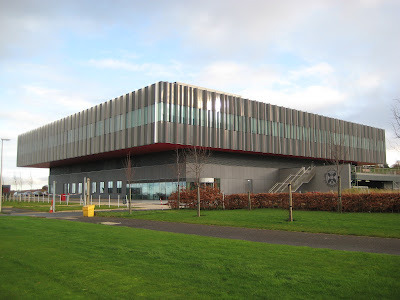
Cathy and I consulted graphic-novel guru David Bishop at Napier, who explained how comics scripts are written and suggested books to read. I went off and read them, then wrote the script. Comics artist Edward Ross and his colleague, Glasgow University PhD student Jamie Hall, did the design and artwork. Meanwhile Edward and Jamie were just finishing a rather longer comic on malaria, and Edward and his wife were expecting a happy event (now happily eventuated, as you can see from the pram handle in the picture below), but they took it all in their stride. The script (and some panels - none of us will forget the blastocyst picture) went through several iterations, as we and some of Cathy's colleagues tore successive drafts to shreds.
For all that, we finished on time and in budget, and it was a proud moment when we all got the finished article in our hands.
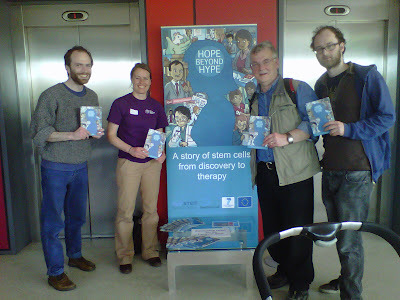
Published on May 20, 2012 23:52
May 18, 2012
Moon over Gotham
It's now a fortnight since I went to America for a panel at the PEN World Voices Festival of International Literature, and high time I wrote about it. PEN American Center looked after me very well, and paid for my flights, accommodation and transport.
Early on Friday afternoon I was met at Newark NJ airport by a driver from Diva
Limo, who whisked me to the hotel, the Jolly Madison Towers on 38th and Madison
(near Grand Central). The hotel was splendid and the room was good - nothing
fancy, but plenty of room and everything ship-shape. So I had a shower and then
walked down 3rd Avenue to the main Festival hotel, the Standard in Cooper
Square. I was wearing my black boots (as they're the nearest I have to smart
shoes) and I got a blister that hurt for the rest of my stay - by Monday it was
quite painful, though it started to go as soon as I got home and changed back into
trainers.
Anyway, I enjoyed the walk, which took about forty minutes. The Standard is just across from the old Cooper Union building and next door to the new one, which looks like an aluminium Culture Ship.
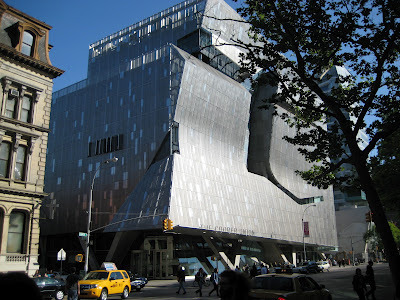
Just off the reception at the Standard is a quiet parlour called the Library, with books around the walls and lots of sofas and soft chairs. This room was being used as the PEN hospitality suite. It opens onto a plaza with tables and more seats. I introduced myself to a young lady sitting with a laptop beside by a stack of Festival programmes. Her name was Emma Connolly and she welcomed me on behalf of PEN. I drank some water and ate a pastry from the table and I was just replying to an email from Julian Sanchez when he walked in. He's 33 and thin and talks as enthusiastically as Charlie Stross. He was wearing jeans, a striped jacket, and shirt with a bow tie: the very image of a Cato Institute free-market libertarian.
Talking and smoking as I hirpled beside him, Julian took me out for a drink via a lecture he wanted to hear at a nearby university, where a conference was going on on Anonymity and Identity in the Digital Age. This turned out to be actually relevant to both the panel topic and my thinking about my next book: there was an intriguing discussion of how anonymous can data really be - if, say, patients' medical records are used for epidemiological (etc) purposes, the more relevant facts a given record includes the less effectively it's anonymized. Julian put the point in a self-acknowledged geeky way: '"Sarah Connor"', he said, 'is not a unique identifier - but that doesn't help Sarah Connor.'
What really struck me from the discussion was how confident everyone was that legislators were open to rational persuasion, and that between good programming practice (with a bit of revision I could design the SQL or Excel query myself) and well-formulated regulation that particular problem could be solved.
We had drinks in a dim but posh tavern and I impressed Julian with my e-cig if not my now jet-lagged conversation. Then we went back to the hotel and into its fine bar (which is opposite the main doors, glass-walled and accessible from the street) to join Julian's girl-friend Kashmir (who is a reporter for Forbes and is nice) and some of their friends. Julian, Kashmir and I had dinner in a Vietnamese vegetarian restaurant in the East Village for something ridiculous like $20 each including tip. By this time it was about ten and I left them at the hotel and walked back to mine. I hit the sack and got a good night's sleep, followed by a good continental breakfast. I went for a stroll around the vicinity, which turned out to be the Fashion District (mostly closed for Saturday), then back to the hotel in time to be picked up by another Diva Limo car at noon.
The line-up for the panel, in the new Cooper Union, was: Larry Siems introducing, Julian chairing, Catherine Crump from the ACLU, me, and Russian writer Ludmilla Ulitskaya and Romanian writer Gabriella Adameșteanu (who turned up with three or four friendly people from the Romanian Cultural Institute).
Ludmilla and Gabriella had interpreters on stage, which made made the discussion a bit less free-flowing than usual (and bit odd for me because of the whispering at either side). But it seemed to go well, and everyone I spoke to afterwards said that it had. It was covered in the New York Times, though Julian felt (and I agree) that the report cast an unfounded aspersion on him.
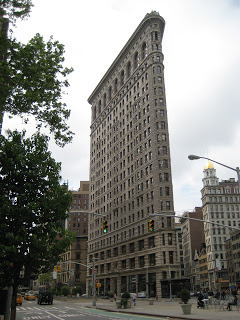 Patrick and Teresa Nielsen Hayden were there and took me, Julian, and Kashmir out for a late lunch at a Ukrainian diner. At one point Julian was talking about an alarmist article he'd read about the countermeasures teenagers take against electronic tracking by their parents, and Patrick remarked: 'We're raising kids to behave like characters in spy novels!'
Patrick and Teresa Nielsen Hayden were there and took me, Julian, and Kashmir out for a late lunch at a Ukrainian diner. At one point Julian was talking about an alarmist article he'd read about the countermeasures teenagers take against electronic tracking by their parents, and Patrick remarked: 'We're raising kids to behave like characters in spy novels!'
Patrick invited me to drop by Tor any time between 12 and 3 on Monday. After Patrick and Teresa headed home, I left Julian and Kashmir on the way to the hotel and set off for St Mark's Bookshop, which I was sure was in St Mark's Place. It wasn't, but I had an interesting walk finding out. The bookshop itself was just as I remembered it from my previous visit back in the late 90s, full of academic left (cultural studies etc) and general books in so many bookcases that it's hard not to brush against a sharp corner. (This happened to my son Michael that time, making a tiny scratch on the casing of a new sports watch he'd saved for for months and had just bought at Nike. I still have a pang about that.)
In a back corner are two revolving racks of left-wing journals. One contains the respectable left (In These Times, Dollars and Sense, ISJ) and the other the far left and ultra-left: Spartacist, Maoist, and three left-communist journals which are as mutually hostile and politically indistinguishable as they were when I first encountered them in Compendium in Camden in 1976 and whose format, layout and fonts, as well as their contents, are exactly the same as they were then. I gave all these a cursory browse and a determined miss and bought a copy of Strunk's The Elements of Style, for about $4.
Looking for something to do before the party at 10, I found a poetry event in the ground floor of the Standard, and very good it was too, with a lively young black MC and several poets. One was pregnant - 'She's eating for two, and she's reading for two!' the MC said. There was a real feeling of a buzz of new poetry and experiment. Also, free wine, cocktails and cookies.
I made the most of left-over wine and cookies while hanging around the plaza until the party. It was in the 21st-floor penthouse, which had a huge suite (including a bedroom) and an all-round balcony, which had as you can imagine (you'll have to, because my camera was recharging) the most amazing views of Manhattan at night.
'This is Ayn Rand's New York!' I said to Emma Connolly, the nice young woman who'd greeted me. 'All it needs is a naked man on a cliff,' she replied, impressing me with her knowledge of The Fountainhead.
Later I got into a conversation with Leily Kleinbard, who as well as working for PEN works with Larry Seims and others on Reckoning With Torture, a project to develop a film that they hope will go viral. I agreed whole-heartedly with the aim, but in articulating my own fury and frustration on the issue I'm afraid I bent her ear a bit (though she assured me later I hadn't).
Around midnight I saw that Oana Radu, one of the women I'd spoken with earlier from the Romanian cultural centre, had her coat on and went over to say goodnight. It turned out her hotel was near mine so we shared a taxi which dropped her off.
The following morning I strolled down Madison Avenue to Washington Square and then into Greenwich Village, took a phone call from the editor of a computer magazine that's publishing a short story I've just written, and then walked over to Cooper Union to listen to a panel on Occupy with the editors of the Occupy! Gazette.
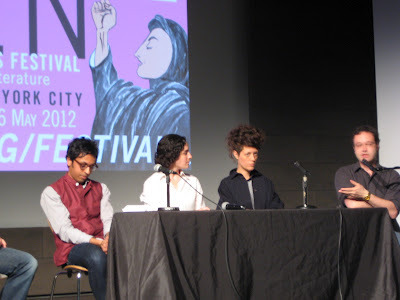
After this I mooched about for a bit, had an over-priced but welcome bagel, walked around a few blocks of the East village, and just before five joined the block-long queue for Salman Rushdie's Arthur Miller Lecture. This was in the main auditorium of the old Cooper Union, a most impressive hall which was packed with mostly young people. Rushdie's talk, as you can see from the video, was brief, witty and interesting, and followed by a Q & A session with Gary Shteyngart, the American son of Russian dissidents.
I bought a $20 Metro pass (spending exactly $10 too much, as I thought at this time that I'd have to make my own way to the airport) and took the line up to Grand Central, went back to the hotel and showered and changed. Back down for 8.30.
The party was in the top of the Clock Tower of the old Cooper Union: one bare room, with an opening to a balcony, and the workings of the clock itself on show inside. The party started slowly but soon got busy. Early on I joined others outside to see the moon rising, huge and orange, just one night after full.
It felt strange being in the same room as Salman Rushdie, and I hung around the edge of a semi-circle around him on the balcony while he held forth on the short film 'Powers of Ten', which he said showed the non-existence of God. I chatted to a few people, including Beth Weinstein, who'd arranged everything for me and who I met for the first time there. She told me that a car would pick me up for the airport.
I took the subway back after the party finished at 11.
Monday morning I got breakfast, showered, packed, checked out and left my luggage and took the subway to the nearest station to the Flatiron. When I turned up at noon Patrick asked me to come back in an hour. I wandered on, around a small branch of Barnes & Noble, and back. Patrick took me and Steve Gould out to lunch, which was good, then recommended I should check out Union Square, which he said was the real heart of New York. I walked down and found a busy organic market and an Occupy stall and a generally lively scene.
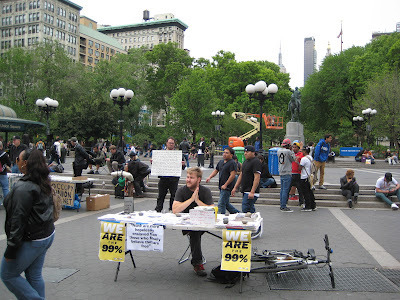
Subway back to hotel, car to airport, home! - and jet-lag for a fortnight.
Early on Friday afternoon I was met at Newark NJ airport by a driver from Diva
Limo, who whisked me to the hotel, the Jolly Madison Towers on 38th and Madison
(near Grand Central). The hotel was splendid and the room was good - nothing
fancy, but plenty of room and everything ship-shape. So I had a shower and then
walked down 3rd Avenue to the main Festival hotel, the Standard in Cooper
Square. I was wearing my black boots (as they're the nearest I have to smart
shoes) and I got a blister that hurt for the rest of my stay - by Monday it was
quite painful, though it started to go as soon as I got home and changed back into
trainers.
Anyway, I enjoyed the walk, which took about forty minutes. The Standard is just across from the old Cooper Union building and next door to the new one, which looks like an aluminium Culture Ship.

Just off the reception at the Standard is a quiet parlour called the Library, with books around the walls and lots of sofas and soft chairs. This room was being used as the PEN hospitality suite. It opens onto a plaza with tables and more seats. I introduced myself to a young lady sitting with a laptop beside by a stack of Festival programmes. Her name was Emma Connolly and she welcomed me on behalf of PEN. I drank some water and ate a pastry from the table and I was just replying to an email from Julian Sanchez when he walked in. He's 33 and thin and talks as enthusiastically as Charlie Stross. He was wearing jeans, a striped jacket, and shirt with a bow tie: the very image of a Cato Institute free-market libertarian.
Talking and smoking as I hirpled beside him, Julian took me out for a drink via a lecture he wanted to hear at a nearby university, where a conference was going on on Anonymity and Identity in the Digital Age. This turned out to be actually relevant to both the panel topic and my thinking about my next book: there was an intriguing discussion of how anonymous can data really be - if, say, patients' medical records are used for epidemiological (etc) purposes, the more relevant facts a given record includes the less effectively it's anonymized. Julian put the point in a self-acknowledged geeky way: '"Sarah Connor"', he said, 'is not a unique identifier - but that doesn't help Sarah Connor.'
What really struck me from the discussion was how confident everyone was that legislators were open to rational persuasion, and that between good programming practice (with a bit of revision I could design the SQL or Excel query myself) and well-formulated regulation that particular problem could be solved.
We had drinks in a dim but posh tavern and I impressed Julian with my e-cig if not my now jet-lagged conversation. Then we went back to the hotel and into its fine bar (which is opposite the main doors, glass-walled and accessible from the street) to join Julian's girl-friend Kashmir (who is a reporter for Forbes and is nice) and some of their friends. Julian, Kashmir and I had dinner in a Vietnamese vegetarian restaurant in the East Village for something ridiculous like $20 each including tip. By this time it was about ten and I left them at the hotel and walked back to mine. I hit the sack and got a good night's sleep, followed by a good continental breakfast. I went for a stroll around the vicinity, which turned out to be the Fashion District (mostly closed for Saturday), then back to the hotel in time to be picked up by another Diva Limo car at noon.
The line-up for the panel, in the new Cooper Union, was: Larry Siems introducing, Julian chairing, Catherine Crump from the ACLU, me, and Russian writer Ludmilla Ulitskaya and Romanian writer Gabriella Adameșteanu (who turned up with three or four friendly people from the Romanian Cultural Institute).
Ludmilla and Gabriella had interpreters on stage, which made made the discussion a bit less free-flowing than usual (and bit odd for me because of the whispering at either side). But it seemed to go well, and everyone I spoke to afterwards said that it had. It was covered in the New York Times, though Julian felt (and I agree) that the report cast an unfounded aspersion on him.
 Patrick and Teresa Nielsen Hayden were there and took me, Julian, and Kashmir out for a late lunch at a Ukrainian diner. At one point Julian was talking about an alarmist article he'd read about the countermeasures teenagers take against electronic tracking by their parents, and Patrick remarked: 'We're raising kids to behave like characters in spy novels!'
Patrick and Teresa Nielsen Hayden were there and took me, Julian, and Kashmir out for a late lunch at a Ukrainian diner. At one point Julian was talking about an alarmist article he'd read about the countermeasures teenagers take against electronic tracking by their parents, and Patrick remarked: 'We're raising kids to behave like characters in spy novels!' Patrick invited me to drop by Tor any time between 12 and 3 on Monday. After Patrick and Teresa headed home, I left Julian and Kashmir on the way to the hotel and set off for St Mark's Bookshop, which I was sure was in St Mark's Place. It wasn't, but I had an interesting walk finding out. The bookshop itself was just as I remembered it from my previous visit back in the late 90s, full of academic left (cultural studies etc) and general books in so many bookcases that it's hard not to brush against a sharp corner. (This happened to my son Michael that time, making a tiny scratch on the casing of a new sports watch he'd saved for for months and had just bought at Nike. I still have a pang about that.)
In a back corner are two revolving racks of left-wing journals. One contains the respectable left (In These Times, Dollars and Sense, ISJ) and the other the far left and ultra-left: Spartacist, Maoist, and three left-communist journals which are as mutually hostile and politically indistinguishable as they were when I first encountered them in Compendium in Camden in 1976 and whose format, layout and fonts, as well as their contents, are exactly the same as they were then. I gave all these a cursory browse and a determined miss and bought a copy of Strunk's The Elements of Style, for about $4.
Looking for something to do before the party at 10, I found a poetry event in the ground floor of the Standard, and very good it was too, with a lively young black MC and several poets. One was pregnant - 'She's eating for two, and she's reading for two!' the MC said. There was a real feeling of a buzz of new poetry and experiment. Also, free wine, cocktails and cookies.
I made the most of left-over wine and cookies while hanging around the plaza until the party. It was in the 21st-floor penthouse, which had a huge suite (including a bedroom) and an all-round balcony, which had as you can imagine (you'll have to, because my camera was recharging) the most amazing views of Manhattan at night.
'This is Ayn Rand's New York!' I said to Emma Connolly, the nice young woman who'd greeted me. 'All it needs is a naked man on a cliff,' she replied, impressing me with her knowledge of The Fountainhead.
Later I got into a conversation with Leily Kleinbard, who as well as working for PEN works with Larry Seims and others on Reckoning With Torture, a project to develop a film that they hope will go viral. I agreed whole-heartedly with the aim, but in articulating my own fury and frustration on the issue I'm afraid I bent her ear a bit (though she assured me later I hadn't).
Around midnight I saw that Oana Radu, one of the women I'd spoken with earlier from the Romanian cultural centre, had her coat on and went over to say goodnight. It turned out her hotel was near mine so we shared a taxi which dropped her off.
The following morning I strolled down Madison Avenue to Washington Square and then into Greenwich Village, took a phone call from the editor of a computer magazine that's publishing a short story I've just written, and then walked over to Cooper Union to listen to a panel on Occupy with the editors of the Occupy! Gazette.

After this I mooched about for a bit, had an over-priced but welcome bagel, walked around a few blocks of the East village, and just before five joined the block-long queue for Salman Rushdie's Arthur Miller Lecture. This was in the main auditorium of the old Cooper Union, a most impressive hall which was packed with mostly young people. Rushdie's talk, as you can see from the video, was brief, witty and interesting, and followed by a Q & A session with Gary Shteyngart, the American son of Russian dissidents.
I bought a $20 Metro pass (spending exactly $10 too much, as I thought at this time that I'd have to make my own way to the airport) and took the line up to Grand Central, went back to the hotel and showered and changed. Back down for 8.30.
The party was in the top of the Clock Tower of the old Cooper Union: one bare room, with an opening to a balcony, and the workings of the clock itself on show inside. The party started slowly but soon got busy. Early on I joined others outside to see the moon rising, huge and orange, just one night after full.
It felt strange being in the same room as Salman Rushdie, and I hung around the edge of a semi-circle around him on the balcony while he held forth on the short film 'Powers of Ten', which he said showed the non-existence of God. I chatted to a few people, including Beth Weinstein, who'd arranged everything for me and who I met for the first time there. She told me that a car would pick me up for the airport.
I took the subway back after the party finished at 11.
Monday morning I got breakfast, showered, packed, checked out and left my luggage and took the subway to the nearest station to the Flatiron. When I turned up at noon Patrick asked me to come back in an hour. I wandered on, around a small branch of Barnes & Noble, and back. Patrick took me and Steve Gould out to lunch, which was good, then recommended I should check out Union Square, which he said was the real heart of New York. I walked down and found a busy organic market and an Occupy stall and a generally lively scene.

Subway back to hotel, car to airport, home! - and jet-lag for a fortnight.
Published on May 18, 2012 03:20
April 30, 2012
A few reviews of The Night Sessions
The US edition of The Night Sessions is getting some thoughtful reviews online: from A Progressive on the Prairie, The King of Elfland's Second Cousin, Shiny Book Review, and Lex Communis. That last explores the book's religious angle from the interestingly different perspective of 'an unrepentant neo-Conservative, Catholic' viewpoint, and is strikingly generous. The author has been good enough to post his review on Amazon, so if you want to give it a thumbs-up, you know what to do.
Published on April 30, 2012 23:44
Putting the Science in Fiction
Last Wednesday's day-long workshop Putting the Science in Fiction was a big success, drawing about a hundred participants of whom many were new faces to jaded old hands like me. It was so cool it even had a hashtag, #SciFicManc. A press release got picked up by The Guardian, where, in a further demonstration of the event's cool cutting-edginess, it got the predictably depressing and idiotic stream of comments that no worthwhile idea or initiative should fail to attract.
At lunch-time I found a handful of people from the disciplines of media studies and science studies in a huddle, aghast at the naivety of the ideas the rest of us had about science and fiction. As mere practitioners of one or the other (or both) we were treating each in their different ways as quite unproblematic representations of reality, and the problem as matching them up. I saw their point, but it was somewhat blunted by an earlier coffee-break conversation I'd had with a science studies guy who assured me that all scientific knowledge was confirmed by social processes, not by further experiment (or words to that effect). When I protested that a lot of scientific discoveries had become established fact, literally solidly proven by (e.g.) the very floor we stood on, he assured me that that sort of thing (what goes into making trains, planes, and automobiles, etc) was 'engineering knowledge' and not science at all. Nevertheless I tossed a plea for some attention to critical media and science studies into the afternoon's discussion, where it sank without a ripple.
My own preferred model (sketched out in late-night conversations with Iain Banks, long ago) for how scientists and SF writers should interact with movies and television is the approval-stamp from the American Humane Society that you see in the credits. A little line saying 'No elementary scientific truth or serious science-fictional speculation was harmed, distorted, or mangled beyond all recognition in the making of this motion picture' would not be much, but it would be a start.
At lunch-time I found a handful of people from the disciplines of media studies and science studies in a huddle, aghast at the naivety of the ideas the rest of us had about science and fiction. As mere practitioners of one or the other (or both) we were treating each in their different ways as quite unproblematic representations of reality, and the problem as matching them up. I saw their point, but it was somewhat blunted by an earlier coffee-break conversation I'd had with a science studies guy who assured me that all scientific knowledge was confirmed by social processes, not by further experiment (or words to that effect). When I protested that a lot of scientific discoveries had become established fact, literally solidly proven by (e.g.) the very floor we stood on, he assured me that that sort of thing (what goes into making trains, planes, and automobiles, etc) was 'engineering knowledge' and not science at all. Nevertheless I tossed a plea for some attention to critical media and science studies into the afternoon's discussion, where it sank without a ripple.
My own preferred model (sketched out in late-night conversations with Iain Banks, long ago) for how scientists and SF writers should interact with movies and television is the approval-stamp from the American Humane Society that you see in the credits. A little line saying 'No elementary scientific truth or serious science-fictional speculation was harmed, distorted, or mangled beyond all recognition in the making of this motion picture' would not be much, but it would be a start.
Published on April 30, 2012 03:10
'It's life Jimmy, but not as we know it'
The National Library of Scotland has an exhibition, running until the end of June, of science fiction in Scotland. The exhibition is compact but comprehensive, with proportionate weight given to SF work in genre and mainstream modes, to comics, TV and films, and with unabashed exhibits of garish covers and artwork alongside fragile manuscripts and antiquarian rarities. SF is treated with the kind of respect and attention to detail that you might expect from someone who has a real love and knowledge of the genre - which turns out to be the case, as curator John Birch (above) explains.
In related videos you can see (so far) me, Charlie Stross and Gary Gibson give our various takes on being SF writers. Eventually these videos and others will be on the NLS site, but for now, enjoy on YouTube and, if you happen to be in Edinburgh in the next couple of months, drop in on the exhibition.
Published on April 30, 2012 02:49
April 23, 2012
Upcoming manifestation in New York

I'm delighted and honoured to have been invited to be on a panel on 'Life in the Panopticon' on Saturday May 5th at the Cooper Union in NYC, as part of the upcoming PEN World Voices Festival of International Literature.
Tiny surveillance drones that hover and stare. An Internet where every keystroke is recorded. The automated government inspection of hundreds of millions of e-mails for suspicious characteristics. The technological advancements spurred by the computing revolution have improved our lives, but have also diminished our privacy and enhanced the government’s power to monitor us. Writers and directors who have grappled with technology’s mixed blessings join civil liberties advocates to discuss ways of preserving our freedom in an era in which we all dwell in Bentham’s Panopticon—a prison that allows our wardens to observe us at all times without being seen themselves.
Published on April 23, 2012 23:18
Ken MacLeod's Blog
- Ken MacLeod's profile
- 762 followers
Ken MacLeod isn't a Goodreads Author
(yet),
but they
do have a blog,
so here are some recent posts imported from
their feed.



